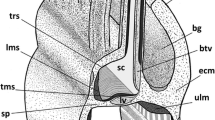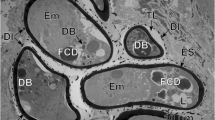Abstract
An electron microscope study of the epithelial cells of the outer and middle mantle folds of the lamellibranchMacrocallista maculata was undertaken. As many previous studies have shown for other species, the periostracum is elaborated by the epithelial cells of the outer fold. Our studies have shown additional details in regard to the structure and function of these cells as follows:
The cells of the middle fold are columnar in appearance and exhibit prominent granules and stout tegumental fibers. They are continuous with those of the outer fold and serve as the base of the periostracal groove. Immediately distal to the cells making up the base of the groove can be observed one or more cells differing from other cells lining the mantle. They have been designated “basal” cells. These cells give rise to a dense layer of material (a pellicle) in an unusual manner. It is evntually arranged in close proximity to the microvilli of the epithelia of the middle fold.
The epithelia of the outer fold is of two types. Those located in the basal region are tall, columnar, contain stout tegumental fibers, elongated microvilli, numerous distended cisternae, glycogen rosettes, and ribosomes. They secrete an opaque substance which subsequently undergoes changes to form the periostracum. The middle third of the outer fold is also concerned with the secretion of material destined to become periostracum. The cells of the distal third of the outer fold differ from those of the basal portion as follows: They are shorter and wider, exhibit serrated cell membranes, contain fewer vacuoles, less glycogen, more ribosomes, and occasional lysosomes. The periostracum when finally formed consists of three zones. The two zones adjacent to the middle fold are extremely dense. The third zone, adjacent to the outer fold is electron opaque.
Résumé
Une étude de miscroscopie électronique des cellules épithéliales des replis externe et moyen du manteau deMacrocallista maculata (Lamellibranchiata) a été réalisée. Des études antérieures ont montré que le periostracum est élaboré par les cellules épithéliales du repli externe. La structure et la fonction de ces cellules ont pu être précisées.
Les cellules du repli moyen ont un aspect cylindrique et présentent des granulations et des fibres tégumentaires nettes. Elles sont en contimuité avec celles du repli externe et constituent la base du sillon periostracal. Une ou plusieurs cellules distinctes des cellules bordantes du manteau sont situées distalement par rapport aux cellules constituant la base de ce sillon. Ces éléments cellulaires distincts constituent une couche dense (une pellicule), en rapport étroit avec les microvillosités de l'épithélium du repli moyen.
L'épithélium du repli externe est de deux types. Les cellules de la région basale sont grandes, cylindriques, et contiennent des fibres tégumentaires nettes ainsi que des microvillosités allongées, des cavités ergastoplasmiques dilatées, des amas de glycogène et des ribosomes. Elles sécrètent une substance opaque qui se transforme en periostracum. Le tiers moyen du repli externe participe aussi à l'élaboration de sécrétion qui participe à la formation du periostracum. Les cellules du tiers distal du repli externe se différencient de celles de la partie basale par les caractères suivants. Elles sont plus courtes et plus larges; leur membrane cytoplasmique est dentelée. Elles contiennent moins de vacuoles, de glycogène et plus de ribosomes ainsi que quelques lysosomes. Le periostracum adulte comporte trois zones. Les deux zones adjacentes du repli moyen sont très denses. La troisième zone, adjacente au repli externe, est opaque aux électrons.
Zusammenfassung
Mit Hilfe des Elektronenmikroskops wurde die äußere und mittlere Membranfalte vonMacrocallista maculata untersucht. Wie schon frühere Untersuchungen an anderen Species gezeigt haben, wird das Periostracum von den Epithelzellen der äußeren Falte gebildet. Unsere Untersuchungen haben die folgenden zusätzlichen strukturellen und funktionellen Besonderheiten dieser Zellen ergeben:
Die Zellen der mittleren Falte sind columnar und zeigen eine ausgeprägte Granulierung und kräftige Tegumentalfasern. Sie stehen mit den Zellen der äußeren Falte in Verbindung und bilden die Basis für die periostracale Furche. Unmittelbar distal von diesen Zellen beobachtet man einen Zelltyp, der sich von den anderen, die Membran auskleidenden Zellen unterscheidet. Diese Zellen werden als „Basalzellen” bezeichnet. Auf eine ungewöhnliche Art produzieren diese Zellen eine dicke (häutchenartige) Schicht einer Substanz, die schließlich in unmittelbarer Nähe der Microvilli der Epithelien abgelagert wird.
Das Epithel der äußeren Falte besteht aus zwei Zelltypen. Die Zellen der Basalmembran sind hoch, columnar, zeigen kräftige Tegumentalfasern, längliche Microvilli, zahlreiche ausgedehnte Zisternen und Glykogenrosetten, und Ribosomen. Sie sezernieren eine opake Substanz, die in der Folge gewissen Veränderungen unterliegt und schließlich das Periostracum bildet. Das mittlere Drittel der äußeren Falte ist ebenfalls an der Sekretion von Material beteiligt, das später das Periostracum bildet. Die Zellen des distalen Drittels der äußeren Falte unterscheiden sich von denen der Basalschicht wie folgt: sie sind kürzer und breiter, haben eine gezahnte Zellmembran, enthalten eine geringere Zahl von Vacuolen, weniger Glykogen, mehr Ribosomen und gelegentlich Lysosomen. Das vollständig ausgebildete Periostracum besteht aus drei Zonen. Die beiden der mittleren Falte benachbarten Zonen sind extrem dicht. Die dritte Zone, der äußeren Falte benachbart, ist für Elektronen undurchlässig.
Similar content being viewed by others
References
Beedham, G. E.: Properties of non-calcareous material in the shell ofAnodonta cygnea. Nature (Lond.)174, 750–752 (1954).
—: Observations on the mantle of the Lamellibranchia. Quart. J. Micr. Sci.99, 2, 181–197 (1958).
Brown, C. H.: Some structural proteins ofMytilus edulis. Quart. J. micr. Sci.93, 4, 487–502 (1952).
Haas, F.: Bronns Klassen und Ordnung des Tier-Reichs. III. Bd., Abt. 3. Bivalvia, Teil 1. 1935.
Hillman, R. E.: Formation of the periostracum inMercenaria mercenaris. Science134, 1754–1755 (1961).
Kado, Y.: The distribution of alkaline phosphatase in mantle tissue of bivalves. J. Sci. Hiroshima Univ., Ser. B,1, 15, 1–6 (1954).
Kawaguti, S., andN. Ikemoto: Electron microscopy on the mantle of a bivalve,Fabulina nitidula. Biol. J. Okayama.8, 1–2, 21–30 (1962a).
——: Electron microscopy on the mantle of the bivalved gastropod. Biol. J. Okayama Univ.8, 1–2, 1–20 (1962b).
Kawakami, I. K., andG. Yasuzumi: Electron microscope studies on the mantle of the pearl oysterPinctada martensii Dunker. Prelim. report. The fine structure of the periostracum fixed with permanganate. J. Electron Microscopy13, 3, 119–123 (1964).
Korringa, P.: On the nature and function of chalky deposits in the shell ofOstrea edulis Linn. Proc. Calif. Acad. Sci.27, 5, 133–158 (1951).
Revel, J. P.: Electron microscopy of glycogen. J. Histochem. Cytochem.12, 2, 104–114 (1964).
Tsujii, T.: Studies on the mechanism of shell and pearl formation in mollusca. J. Fac. Fisheries. Prefectural Univ. Mie.5, 1, 1–70 (1960).
Yonge, C. M.: Mantle fusion in the Lamellibranchia. Pubbl. staz. zool. Napoli.29, 151–171 (1957).
Author information
Authors and Affiliations
Additional information
This investigation was aided (in part) by grant DE-01825, N.I.D.R., U.S.P.H.
Rights and permissions
About this article
Cite this article
Bevelander, G., Nakahara, H. An electron microscope study of the formation of the periostracum ofMacrocallista maculata . Calc. Tis Res. 1, 55–67 (1967). https://doi.org/10.1007/BF02008075
Received:
Issue Date:
DOI: https://doi.org/10.1007/BF02008075




